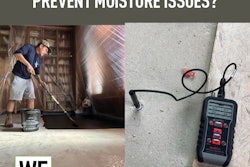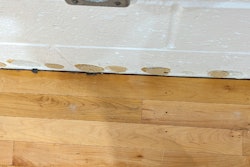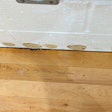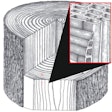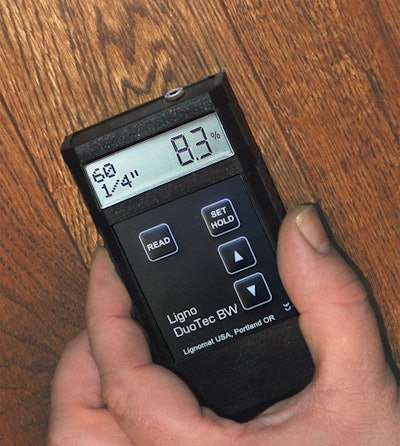
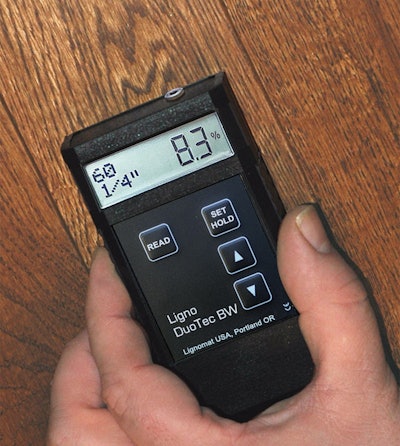 The ideal combination meter for the flooring industry. The Ligno-DuoTec BW is a pinless, dual-depth moisture meter with an optional attachment to measure relative humidity and temperature. The meter can be set for a measuring depth of ¼-inch and ¾-inch.
The ideal combination meter for the flooring industry. The Ligno-DuoTec BW is a pinless, dual-depth moisture meter with an optional attachment to measure relative humidity and temperature. The meter can be set for a measuring depth of ¼-inch and ¾-inch.
 The Ligno-Duotec BW is used as a thermo-hygrometer to check whether or not the climate surrounding the wood floor guarantees that the floor will not absorb or loose moisture.
The Ligno-Duotec BW is used as a thermo-hygrometer to check whether or not the climate surrounding the wood floor guarantees that the floor will not absorb or loose moisture.
Wood floors have been used in buildings for centuries. And if maintained properly, they will keep their strength and beauty for a long time. One factor, which will affect all wood floors, is its MC. When the MC changes to a higher level, wood will expand, and crowning or buckling will occur. When the MC changes to a lower level, wood will shrink, and cupping and gapping will occur.
Wood is a hygroscopic material, which absorbs or loses moisture until an equilibrium between the wood moisture and the relative humidity of the surrounding air has been reached. See the EMC chart in this article for stable moisture and humidity values.
The wrong "climate" can ruin the most beautiful floor. Moisture meters and thermo-hygrometers are needed to measure if the conditions are right to acclimate, install and maintain a stable floor. Right or wrong is all explained in the EMC chart.
The first photo at right shows a pinless meter, the Ligno-DuoTec BW from Lignomat measuring a wood floor. The same meter can also be used to very accurately determine the relative humidity and the temperature in the room (as in the second photo).
The EMC graph below shows stable wood MC for any given relative humidity (example 1). Different ambient temperatures have less of an impact. The graph also shows what the relative humidity should be to keep wood stable at any given wood MC (example 2) . You can also predict what a wood floor will do if the MC does not fit the relative humidities listed below. EMC and the corresponding relative humidity can also be found on the Internet; for a graph go to www.lignomatusa.com/emc/.
The EMC chart gives the answer to the question: Why should wood floors be between 6-9%? Inside buildings a comfortable, recommended relative humidity range is between 30-50% at a temperature of 60 to 80 degrees Fahrenheit. According to the chart below, if the relative humidity is 30-50%, then wood is stable if its moisture content is between 6-9%.
Example 1: If the relative humidity in a home is 50%, the stable wood moisture content is about 9%.
Example 2: If a moisture content is at 6%, a good relative humidity would be 30%.
Example 3: If the moisture content of a wood floor is at 11% and the relative humidity is at 40% for longer periods of time, then the wood floor will dry down until it reached 7.7%.

With the chart, predictions can be made for the future. The chart shows if wood will gain or loose moisture to reach EMC expected according to the relative humidity. When a problem has occurred, the EMC chart can help to pinpoint the cause of the problem.
In the spring and fall, the humidity in buildings is usually moderate between 35-45%. That would support a stable wood moisture content of 7.5%. However, during cold winter months, the air humidity drops sometimes drastically lower than 20%. in the summer months the relative humidity could rise to over 60%. Between an RH of 20% and 60%, the change in moisture content is 4.5% to 11%.
 Lignomat's pinless meters have the ability to indicate lower moisture contents than pin meter.
Lignomat's pinless meters have the ability to indicate lower moisture contents than pin meter.
In many buildings nowadays a HVAC unit is installed to keep the humidity in the building within the comfort zone year-round. That is true not only for humans but also keeps the wood floors stable. The problem starts when during the summer break or at Christmas time, the HVAC is turned off for an extended period of time.
Measuring low moisture conditions
Low moisture in floors occur when low relative humidity is present, like in high desert climates or in cold winter months. Under those circumstances, installers and inspectors will encounter a problem with measuring low MC. Pin meters cannot measure these low moisture conditions because the electrical resistance of the wood becomes so high that no measurable current can travel from one pin to the other. That leaves pinless meters to measure low moisture contents. Lignomat's pinless meters are known for their ability to indicate low moisture conditions.
The prevention of floor moisture problems starts with proper installation.
When the wood is delivered on-site, the first series of moisture measurements has to be taken to confirm that the wood has the right MC. Any complaints to the manufacturer should be voiced promptly. The Ligno-Duotec BW would be a good choice, since both wood moisture and humidity can be measured accurately.
 Proper installation starts with checking the wood when it arrives at the job site.
Proper installation starts with checking the wood when it arrives at the job site.
 The data logger can be used starting with the delivery of the floor, during acclimation, installation and later on when the building is occupied. The graph shows relative humidity, temperature, dew point, GPP and EMC. The data logger BL2 records in time intervals between 30 sec and 24 hours and can take 32000 measurements, enough for the first few years after the installation.
The data logger can be used starting with the delivery of the floor, during acclimation, installation and later on when the building is occupied. The graph shows relative humidity, temperature, dew point, GPP and EMC. The data logger BL2 records in time intervals between 30 sec and 24 hours and can take 32000 measurements, enough for the first few years after the installation.
Next comes acclimation. The manufacturer guidelines for acclimation need to be followed. Whatever is required, proper acclimation is only possible when the relative humidity and temperature is the same as later when the building is occupied. The acclimation process should also be monitored with a moisture meter and a thermo-hygrometer. If the relative humidity is kept at service conditions, the floor is fully acclimated when its MC does not change any more within a few days. A data logger could be used to record and thus prove, that the relative humidity was kept at service conditions. See below BL2 data logger with alarm function.
After the acclimation process is finished, the installer starts with his job. And again, he should check the moisture of the floor to be sure the MC is OK at this time. The best installation skills will not produce the expected results if the MC is not right.
Once the building owner signs of on the installation, it is the owner's responsibility to assure good care to keep the floor beautiful.
It is advisable to take moisture measurements at that time. Choose moisture-critical places and get several moisture measurements. With a dual-depth meter from Lignomat you can pin-point the moisture in two levels, ¼" down and ¾" down. Take measurements with both depth settings and note the location, wood species setting, measuring depth, time and date. Also measure the relative humidity with a hygrometer. Keep this documentation. In case of any moisture problems later on, comparison with the original measurements could help to find the cause and the culprit of the problem.
As a last step, the installer should advise the maintenance crew about the importance of keeping the right climate around the newly installed floor. Moisture meters and hygrometers would be good tools for use to look for changes in MC.
If a problem arise, the question always is: Who will pay for the repair? Without any records, it is hard to shift the blame to the guilty party. The floor manufacturer says his floor was perfect when delivered. The installer says at the time he left, the floor was good. The property owner will say he did everything he was supposed to do. The history of moisture measurements and relative humidity readings is critical evidence.
 Photo of a basketball court showing definite damage by excess moisture. After analyzing the problem, it was found, that the outside walls of the building were not insulated properly. Whenever it rained, moisture would migrate through the walls and increase the relative humidity in the gymnasium and enable the floor planks to absorb more and more moisture.
Photo of a basketball court showing definite damage by excess moisture. After analyzing the problem, it was found, that the outside walls of the building were not insulated properly. Whenever it rained, moisture would migrate through the walls and increase the relative humidity in the gymnasium and enable the floor planks to absorb more and more moisture.
Taking moisture measurements from time to time with the same moisture meter in the same location will produce a series of comparable moisture values and indicate problem areas for further investigation.
Whenever a floor moves, moisture is to blame. Detection is the first step to prevention. The essential tools to do that are a moisture meter and a thermo-hygrometer.
More information about moisture and moisture problems go to Lignomat.com and Moisture Facts.















